#Umetae
Photo

Today’s anime dog of the day is:
Umeta from Yami Shibai 9 (2021)
139 notes
·
View notes
Text


I love plum names! 梅田 Umeda (or Umeta) is written with the characters for plum 梅 (ume or bai) and rice paddy 田 (da or den).
Relevant to know, I guess, is that Umeda is the other name for 大阪Ōsaka Station. Some other places have dual names too: 福岡 Fukukoa and 博多 Hakata are interchangeable, for example.
25 notes
·
View notes
Photo

Maiko Ichiaya (Ichi okiya), Umehina and Umetae during the Bon Odori ceremony
(SOURCE)
298 notes
·
View notes
Text

Former Maiko Umetae (Umeno Okiya) of Kamishichiken.
SOURCE
5 notes
·
View notes
Photo

April 2019: Maiko Umehina in a stunning blue, and Maiko Umetae in a gorgeous purple!
(SOURCE)
46 notes
·
View notes
Text

March 2019: Maiko Umetae (Umeno Okiya) of Kamishichiken performing a dance at a wedding, while Geiko Umechika plays the shamisen and sings.
Source: kazan_km on Instagram
#umetae#umechika#umeno okiya#kamishichiken#kimono#hikizuri#furisode#susohiki#kosode#obi#darari obi#obiage#obidome#obijime#oshiroi#makeup#hair#hairstyle#kanzashi#daikin#hairpin#hair ornament#geisha#maiko#geigi#geiko#wareshinobu hairstyle#geiko shimada hairstyle#geisha makeup#hanakanzashi
71 notes
·
View notes
Photo

กุมภาพันธ์ 2562: เกโกะ Umeshizu (โอกิยะ Ichi), และไมโกะ Umetae (โอกิยะ Umeno) จากเขต Kamishichiken กำลังร่ายรำที่ศาลเจ้า Kitano Tenmanguu ระหว่างเทศกาล Setsubun
เขต Kamishichiken อยู่ใกล้กับศาลเจ้า Kitano Tenmanguu มากกว่าศาลเจ้า Yasaka จึงมีเทศกาลสำคัญๆ ของเขตที่จัดขึ้นที่ศาลเจ้า Kitano Tenmanguu และเขต Kamishichiken นี้ยังเป็นเขตเดียวที่อนุญาตให้เกโกะขึ้นแสดงได้ในเทศกาล Setsubun ในขณะที่เขตอื่นจะส่งเฉพาะตัวแทนไมโกะให้ทำการแสดงการร่ายรำ
Source: kwcphoto on Exblog
#umeshizu#umetae#ichi okiya#umeno okiya#kimono#maiko#geiko#setsubun#mai ougi#kyomai#kitano tenmanguu
27 notes
·
View notes
Text
What’s That Thing? Part 21
It’s been a while since we did this feature as I was waiting on some good questions to come in, and they have! I’ve since been hoarding them so that I have a nice stack, so like the knowledge dragon that I am I’ll be sharing my wealth with all of you again ^^!
29goingon90 asked:
“Hello! I have a few questions about Umeno’s green shibori hiki.
A) The color shows quite a bit of variation in places across the garment, and I wondered if this is a regular characteristic of shibori? I’ve seen others with the color “running” like on Umeno’s, indeed, I have a shibori furisode in orange and green that displays it, but I had always thought it was a result of dye migration, discoloration or fading defect. It must be wrong for an okiya to showcase the piece so frequently?
B) Why do we see so much of this hiki? Maybe since I know this one, I spot it right away? Or does it just get used that much relative to other hiki that that makes it recognizable to me?”
Since it’s a two parter let’s tackle this in two parts! First, here’s the kimono in question:
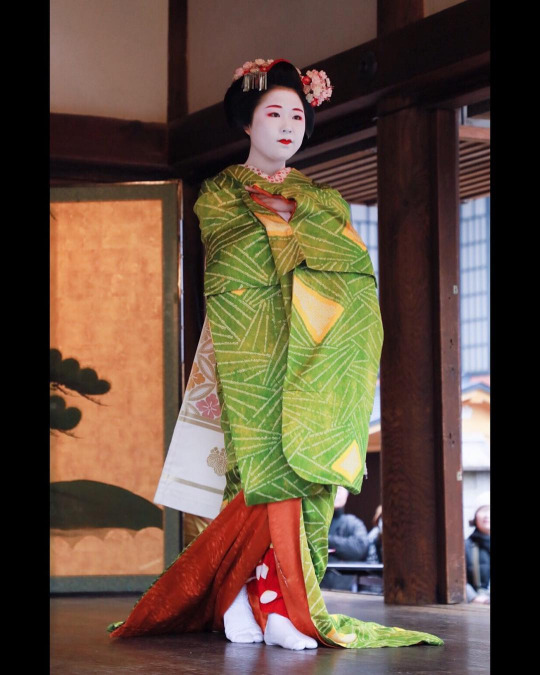
Image courtesy of KWC Photo.
Shibori like this is a bit complicated to make due to multiple colors involved. Most shibori relies on one main color that produces a gradation to look like multiple colors, but is simple(ish) in its execution. In the majority of cases when there are multiple colors involved they tend to be “spot” colors that are applied in small patches; this is most commonly seen with pieces like shibori yukata.
When it comes to this piece, it requires a bit of a different approach in that color here has been applied in layers. The overall piece was first dyed in a light yellow color, which is why we see yellow seemingly coming out of everywhere. From there, the overall green sections were done with a simple geometric design of three/four lines that look a bit like folding fans. If this were a single color shibori piece then the light green areas would be white underneath, but since this was done in two stages they’re actually that sunny yellow. From there, the bold yellow sections were done to finish off the piece.
Because there’s so much dye and so much physical exertion on the silk when shibori is made it can often look “roughed up,” so this is why we see a bit of a blotchy effect on the overall piece. This tends to become more obvious over time as the piece ages and is worn as dye can indeed migrate. Since yellow and green are close colors whose dyes can even be derived from each other it won’t seem as pronounced as if you had almost opposite colors like the OP has.
However, we do know that many of Umeno’s better kimono, like this piece in particular, are upwards of 30 years old, so they’ve seen a great deal of wear! 30 years may seem like a long time, but shibori kimono are among the most expensive type of kimono that an okiya can own, so they are treated with respect and preserved for use for as long as possible.
As for the second question, let’s look at some more visual aids to help us answer this:
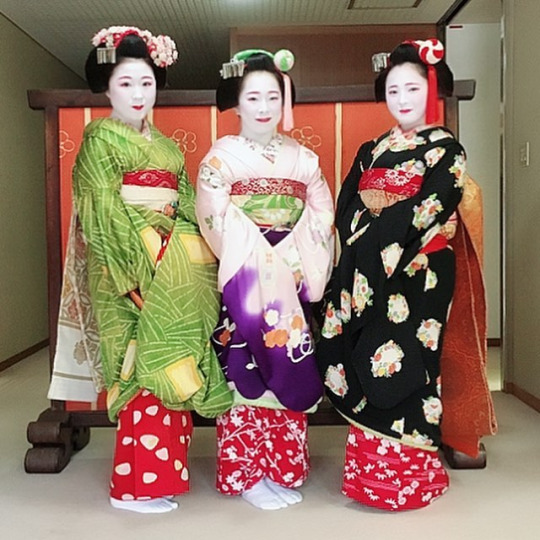
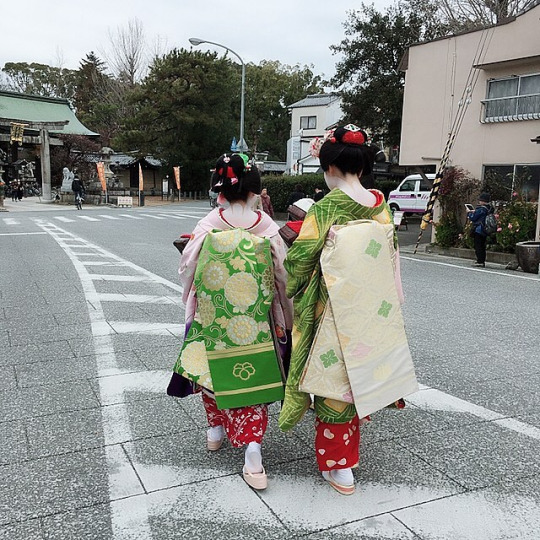
Images are courtesy of Katsufumi.
So, as an experiment, I want you to look at both images above and tell me which kimono stands out the most to you.
For the first image, your eyes are going to go to Fumiyuki in the middle as the contrast between purple and white is very strong. Then, you’ll look at Katsuki on the right as your eyes continue to look around for something to attract you, and the marumon on black is very striking. However, your eyes don’t want to focus on striking for very long, so they’ll immediately then go to Umetae on the left. You may not notice it until a few seconds later, but your eyes have actually focused on Umetae’s kimono longer than the others. Not only is it easier for your eyes to focus on for longer since the colors are similar, but the pattern in the shibori almost tricks your eyes into wanting to follow it around.
In the second, a very similar thing happens. You’ll first be drawn to Fumiyuki’s green obi, but then almost immediately switch over to Umetae’s kimono. Shibori is very pleasing on the eyes, so whoever wears it is bound to stand out.
But, beyond all of that fun science-y stuff, we tend to see shibori kimono only from December through February as those are the only months when wearing shibori is considered appropriate. For nine months this kimono isn’t seen at all, so you aren’t really seeing it often overall, but are highly likely to see more images of it year round because it stands out so much.
So, the overall answer is: The color is natural of the shibori process and nothing to be alarmed about. We see this kimono so often because it’s among the best that the okiya owns and it immediately draws attention to the wearer. Photographers really like images with shibori kimono, so they tend to be uploaded more than regular kimono ^^
#maiko#geiko#geisha#kyoto#kimono#hikizuri#shibori#kamishichiken#umeno#umetae#舞妓#芸妓#芸者#京都#着物#引き摺り#絞り#上七軒#梅乃#梅たえ
25 notes
·
View notes
Photo

February 2018: geiko Tamayuki and Katsuna with maiko Umechie, Umetae and Katsuki leaving the Kitano Tenmangu shrine after Baikasai (source).
#geiko#maiko#geisha#kamishichiken#baikasai#tamayuki#katsuna#umechie#umetae#katsuki#kimono#obi#ohikizuri#kanzashi
74 notes
·
View notes
Photo

November 2017: maiko Umetae and Umechie of the Umeno okiya by exclusivekyoto on Instagram
New blog is up! Visit HERE 🌟 🌟 🌟
༼ つ ◕◡◕ ༽つ Geisha-kai on P a t r e o n || Instagram
44 notes
·
View notes
Photo





「漫画アクション 2019年No.24」 清水綾乃
https://www.amazon.co.jp/dp/B081KQY4WL/
126 notes
·
View notes
Photo

Maiko sisters Umetae and Umesana dancing
(SOURCE)
70 notes
·
View notes
Photo
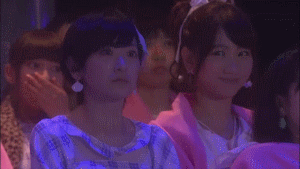
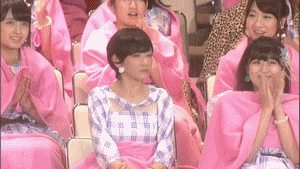
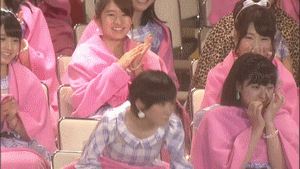
ikoma had one of the best SSK reactions after being called xD
#akb48#nogizaka46#ikoma rina#kashiwagi yuki#izuta rina#takeuchi miyu#umeta ayano#akb48 37th single senbatsu sousenkyo - 2014.06.07 ajinomoto stadium#fukuoka seina#hirata rina
122 notes
·
View notes
Photo

March 2019: The adorable Umetae of Umeno Okiya!
(SOURCE)
18 notes
·
View notes
